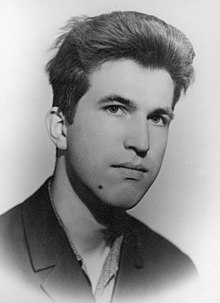Yuri Vladimirovich Miyasevich
Yuri Wladimirowitsch Matijassewitsch ( Russian Ю́рий Влади́мирович Матиясе́вич , English transliteration Yuri Matiyasevich; born March 2, 1947 in Leningrad ) is a Russian mathematician and computer scientist. He gained notoriety after finding a negative answer to David Hilbert's Tenth Problem at the age of 22 and presenting it as a doctoral thesis.
Professional background
Matiyasevich went from 1962 to 1963 to the St. Petersburg Lyceum No. 239 and then from 1963 to 1964 to the Moscow Kolmogorov School. In 1964 he won the International Mathematical Olympiad , which is why his last year of high school was waived and he could immediately begin his mathematics studies at the St. Petersburg State University in 1964. As a student he gave a lecture at the International Congress of Mathematicians in Moscow in 1966 . In 1969 he finished his studies and received his doctorate in 1970 ( Russian candidate title ) at LOMI (now POMI), the St. Petersburg branch of the Steklow Institute for Mathematics . He then did research at LOMI, from 1974 as a senior scientist. In 1970 he solved Hilbert's Tenth Problem, building on works by Julia Robinson , Martin Davis and Hilary Putnam , among others , which made him internationally known. In 1972 he completed his habilitation (Russian doctorate). In 1971 he showed constructively that there is an integer multivariable polynomial that generates exactly the set of prime numbers for positive integer arguments with its positive values . Six years later he was able to prove that a polynomial in 10 variables is sufficient for this.
In 1980 he became head of the Laboratory for Mathematical Logic at LOMI. Since 1995 he has been a professor at the State University of Saint Petersburg, first with a chair in software engineering , then with a chair in algebra and number theory .
He also developed algebraically equivalent statements (via polynomials) for the four-color theorem .
Since 2002 he has headed the jury of the Mathematics Olympiad in Saint Petersburg and since 2003 he has also headed the German-Russian Joint Advanced Student School (JASS).
Awards and honors
- 1964: First place at the International Mathematical Olympiad in Moscow.
- 1970: Prize for Young Mathematicians from the Leningrad Mathematical Society.
- 1970: Invited Speaker at the International Congress of Mathematicians in Nice ( Diophantine representation of recursively enumerable predicates ).
- 1980: A. A. Markov Prize of the Russian Academy of Sciences
- In 1997 he became a corresponding member of the Russian Academy of Sciences and has been its full member since 2008
- 1996: Honorary doctorate from the University of Auvergne (Docteur Honoris Causa de l'Université d'Auvergne).
- 1998: Humboldt Research Award .
- Since 1998 he has been Vice President of the Saint Petersburg Mathematical Society .
- 2003: Honorary doctorate from the University of Pierre and Marie Curie .
- 2007: Member of the Bavarian Academy of Sciences .
Other memberships / activities
- Member of the American Mathematical Society and the Association for Symbolic Logic .
- Member of the editorial board of the journals Discrete Mathematics and Applications and Computer Instruments in Education .
- Member of the Academia Europaea (since 2014)
Others
- A polynomial was named after him, which refers to the coloring of the triangulation of a sphere.
- His Erdős number is 2: Juri Matijassewitsch - Richard Kenneth Guy - Paul Erdős .
Works
Books
- Yuri V. Matiyasevich: Hilbert's 10th Problem , with foreword by Martin Davis and Hilary Putnam , The MIT Press, 1993. ISBN 0-262-13295-8 .
items
- Enumerable Sets are diophantine , Soviet Math. Doklady, 11, 1970, pp. 354-357
- Real-time recognition of the inclusion relation ( on-line version (PDF file; 369 kB)), Journal of Soviet Mathematics, No. 1 (1973), pp. 64-70, ISSN 0090-4104 .
- with Julia Robinson : Reduction of an arbitrary Diophantine equation to one in 13 unknowns ( on-line version ), Acta Arithmetica , XXVII (1975), 521-549.
- with Géraud Sénizergues : Decision Problems for Semi-Thue Systems with a Few Rules ( on-line version ), LICS'96 (on Post's correspondence problem )
- Proof Procedures as Bases for Metamathematical Proofs in Discrete Mathematics ( on-line version ; GZIP ; 34 kB), Personal Journal of Yury Matiyasevich.
- Elimination of bounded universal quantifiers standing in front of a quantifier-free arithmetical formula , ( on-line version ), Personal Journal of Yuri Matiyasevich.
- A Polynomial related to Colorings of Triangulation of Sphere , ( on-line version ), Personal Journal of Yuri Matiyasevich.
- Some Probabilistic Restatements of the Four Color Conjecture ( on-line version ; GZIP ; 163 kB), Journal of Graph Theory, 2003.
- Hilbert's tenth problem: diophantine equations in the twentieth century , in Bolibruch, Osipov, Sinai (editor) Mathematical Events of the Twentieth Century , Springer 2006, p. 185
- My collaboration with Julia Robinson , Mathematical Intelligencer, Volume 14, 1992, No. 4, online
Web links
- John J. O'Connor, Edmund F. Robertson : Yuri Wladimirowitsch Matijassewitsch. In: MacTutor History of Mathematics archive .
- J. Matijassewitschs website (English)
- J. Matijassewitsch in DBLP (English)
- Tenth problem of Hilbert: story of a mathematical discovery (English)
- J. Matiyasevich at the IMO
- Matijassewitsch's Theorem in Scholarpedia (English)
- Summary of work in France (French)
Individual evidence
- ^ Diophantine representation of the set of prime numbers. Soviet Math. Doklady 12 (1971), No. 4, pp. 249-254
- ↑ Primes are non-negative values of a polynomial in 10 variables. (Russian) Sapis. Sem. LOMI AN SSSR 68 (1977) pp. 62-82
- ↑ Именные премии и медали. In: ras.ru. Retrieved April 11, 2017 .
| personal data | |
|---|---|
| SURNAME | Matijassewitsch, Yuri Vladimirovich |
| ALTERNATIVE NAMES | Матиясевич, Юрий Владимирович (Russian); Matiyasevich, Yuri V .; Matijasevič, Jurij V. |
| BRIEF DESCRIPTION | Russian mathematician |
| DATE OF BIRTH | March 2, 1947 |
| PLACE OF BIRTH | Leningrad |
